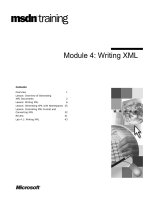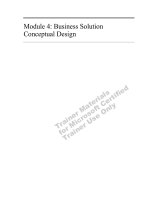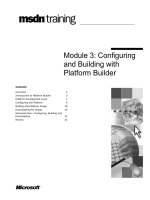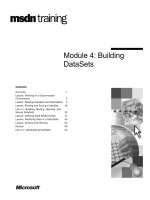Module 4: Configuring Caching
Bạn đang xem bản rút gọn của tài liệu. Xem và tải ngay bản đầy đủ của tài liệu tại đây (1.03 MB, 36 trang )
Contents
Overview 1
Cache Overview 2
Configuring Cache Policy 6
Configuring Cache Settings 17
Configuring Scheduled Content
Downloads 20
Lab A: Configuring Caching 22
Review 29
Module 4:
Configuring Caching
Information in this document is subject to change without notice. The names of companies,
products, people, characters, and/or data mentioned herein are fictitious and are in no way intended
to represent any real individual, company, product, or event, unless otherwise noted. Complying
with all applicable copyright laws is the responsibility of the user. No part of this document may
be reproduced or transmitted in any form or by any means, electronic or mechanical, for any
purpose, without the express written permission of Microsoft Corporation. If, however, your only
means of access is electronic, permission to print one copy is hereby granted.
Microsoft may have patents, patent applications, trademarks, copyrights, or other intellectual
property rights covering subject matter in this document. Except as expressly provided in any
written license agreement from Microsoft, the furnishing of this document does not give you any
license to these patents, trademarks, copyrights, or other intellectual property.
2001 Microsoft Corporation. All rights reserved.
Microsoft, Active Directory, ActiveX, BackOffice, FrontPage, JScript, MS-DOS, NetMeeting,
Outlook, PowerPoint, Visual Basic, Visual C++, Visual Studio, Windows, Windows Media, and
Windows NT are either registered trademarks or trademarks of Microsoft Corporation in the
U.S.A. and/or other countries.
Other product and company names mentioned herein may be the trademarks of their respective
owners.
Instructional Designer: Victoria Fodale (Azwrite LLC)
Technical Lead: Joern Wettern (Independent Contractor)
Program Manager: Robert Deupree Jr.
Product Manager: Greg Bulette
Lead Product Manager, Web Infrastructure Training Team: Paul Howard
Technical Contributors: Ronald Beekelaar, Adina Hagege, Eran Harel, John Lamb, Lucian Lui,
Ron Mondri, Thomas W. Shinder, Bill Stiles (Applied Technology Services), Kent Tegels,
Oren Trutner
Graphic Artist: Andrea Heuston (Artitudes Layout & Design)
Editing Manager: Lynette Skinner
Editor: Stephanie Edmundson
Copy Editor: Kristin Elko (S&T Consulting)
Production Manager: Miracle Davis
Production Coordinator: Jenny Boe
Production Tools Specialist: Julie Challenger
Production Support: Lori Walker ( S&T Consulting)
Test Manager: Peter Hendry
Courseware Testing: Greg Stemp (S&T OnSite)
Creative Director, Media/Sim Services: David Mahlmann
CD Build Specialist: Julie Challenger
Manufacturing Support: Laura King; Kathy Hershey
Operations Coordinator: John Williams
Lead Product Manager, Release Management: Bo Galford
Group Manager, Business Operations: David Bramble
Group Manager, Technical Services: Teresa Canady
Group Product Manager, Content Development: Dean Murray
General Manager: Robert Stewart
Module 4: Configuring Caching iii
Instructor Notes
This module provides students with the knowledge and skills to configure
Microsoft
®
Internet Security and Acceleration (ISA) Server 2000 as a caching
server.
After completing this module, students will be able to:
Describe the cache process that ISA Server uses to process requests from
client computers.
Configure the cache policy.
Configure cache settings.
Configure scheduled content downloads.
Materials and Preparation
This section provides the materials and preparation tasks that you need to teach
this module.
Required Materials
To teach this module, you need the Microsoft PowerPoint
®
file 2159A_04.ppt.
Preparation Tasks
To prepare for this module, you should:
Read all of the materials for this module.
Complete the lab. Make a note of the point in the lab in which you must stop
the Web site on the instructor computer.
Study the review questions and prepare alternative answers to discuss.
Anticipate questions that students may ask. Write out the questions and
provide the answers.
Read “Internet Acceleration” in ISA Server Help.
Read the Microsoft Knowledge Base Article Q234067 at
Read RFC 2616, “Hypertext Transfer Protocol -- HTTP/1.1,” under
Additional Readings on the Trainer Materials compact disc.
Read Appendix A, “ISA Server Caching Criteria,” on the Trainer Materials
compact disc.
Presentation:
30 Minutes
Lab:
30 Minutes
iv Module 4: Configuring Caching
Module Strategy
Use the following strategy to present this module:
Cache Overview
Begin the module by describing the caching functions of ISA Server.
Explain that the caching that ISA Server uses is different from any other
caching that Microsoft Windows
®
2000 or the hardware on the ISA Server
computer may perform. Use the build slides to describe the actions that ISA
Server performs when processing requests for new objects and processing
requests for cached objects.
Configuring Cache Policy
Explain the use of the Time-to-Live (TTL) period for cached objects.
Explain that expiration policies set the TTL for only objects that do not
contain a specific expiration time. Explain the use of active caching and
negative caching. Mention that you can change the error messages that ISA
Server returns by editing the Web pages in the ErrorHtmls folder. Refer
students to Appendix A for a summary of the criteria that ISA Server uses
for caching.
Configuring Cache Settings
Describe the procedure that you use to adjust the cache size. Point out the
.cdat file in the \urlcache folder. Emphasize that if the cache file becomes
corrupted, you cannot modify or delete the \urlcache folder while the
Microsoft Web Proxy service is running.
Configuring Scheduled Content Downloads
Explain that scheduled content downloads enable you to download content
from the Internet directly to the cache according to a predefined schedule.
Mention that you can review the ISA Server reports to determine the most
frequently accessed Web sites in an organization. Describe the key steps
that you perform to configure a scheduled content download.
Module 4: Configuring Caching v
Customization Information
This section identifies the lab setup requirements for a module and the
configuration changes that occur on student computers during the labs. This
information is provided to assist you in replicating or customizing Microsoft
Official Curriculum (MOC) courseware.
The lab in this module is also dependent on the classroom
configuration that is specified in the Customization Information section at the
end of the Classroom Setup Guide for Course 2159A, Deploying and Managing
Microsoft Internet Security and Acceleration Server 2000.
Lab Setup
The following list describes the setup requirements for the lab in this module.
Setup Requirement 1
The lab in this module requires that ISA Server be installed on all ISA Server
computers. To prepare student computers to meet this requirement, perform one
of the following actions:
Complete Module 2, “Installing and Maintaining ISA Server,” in Course
2159A, Deploying and Managing Microsoft Internet Security and
Acceleration Server 2000.
Perform a full installation of ISA Server manually.
Setup Requirement 2
The lab in this module requires that the ISA Server administration tools be
installed on all ISA Server client computers. To prepare student computers to
meet this requirement, perform one of the following actions:
Complete Module 2, “Installing and Maintaining ISA Server,” in Course
2159A, Deploying and Managing Microsoft Internet Security and
Acceleration Server 2000.
Install the ISA Server administration tools manually.
Setup Requirement 3
The lab in this module requires that the Firewall Client software be installed on
all ISA Server client computers. To prepare student computers to meet this
requirement, perform one of the following actions:
Complete Module 2, “Installing and Maintaining ISA Server,” in Course
2159A, Deploying and Managing Microsoft Internet Security and
Acceleration Server 2000.
Install the Firewall Client software manually.
Important
vi Module 4: Configuring Caching
Setup Requirement 4
The lab in this module requires that all of the ISA Server client computers be
configured to use the ISA Server computer’s IP address on the private network
as their default gateway. To prepare student computers to meet this
requirement, perform one of the following actions:
Complete Module 2, “Installing and Maintaining ISA Server,” in Course
2159A, Deploying and Managing Microsoft Internet Security and
Acceleration Server 2000.
Configure the default gateway manually.
Setup Requirement 5
The lab in this module requires that Microsoft Internet Explorer be configured
on all student computers to use the ISA Server computer as a Web Proxy
server. To prepare student computers to meet this requirement, perform one of
the following actions:
Complete Module 2, “Installing and Maintaining ISA Server,” in Course
2159A, Deploying and Managing Microsoft Internet Security and
Acceleration Server 2000.
Configure Internet Explorer manually.
Setup Requirement 6
The lab in this module requires that Internet Information Services (IIS) be
configured on all ISA Server computers to use Transmission Control Protocol
(TCP) port 8008 for the default Web site. To prepare student computers to meet
this requirement, perform one of the following actions:
Complete Module 2, “Installing and Maintaining ISA Server,” in Course
2159A, Deploying and Managing Microsoft Internet Security and
Acceleration Server 2000.
Configure IIS manually.
Setup Requirement 7
The lab in this module requires a protocol rule on the ISA Server computer that
allows users to gain access to all sites by using the Hypertext Transfer Protocol
(HTTP), Hypertext Transfer Protocol- Secure (HTTP-S), and File Transfer
Protocol (FTP) protocols. To prepare student computers to meet this
requirement, perform one of the following actions:
Complete Module 3, “Enabling Secure Internet Access,” in Course 2159A,
Deploying and Managing Microsoft Internet Security and Acceleration
Server 2000.
Create the rule manually.
Lab Results
Performing the lab in this module introduces the following configuration
changes:
The HTTP caching and FTP cache settings are changed.
A scheduled content download job for the Web site www.contoso.msft/lists
is created.
Module 4: Configuring Caching 1
Overview
Cache Overview
Configuring Cache Policy
Configuring Cache Settings
Configuring Scheduled Content Downloads
*****************************
ILLEGAL FOR NON
-
TRAINER USE
******************************
When you deploy Microsoft
®
Internet Security and Acceleration (ISA)
Server 2000 in Cache mode or in Integrated mode, ISA Server maintains a
centralized cache of Internet objects and fulfills client requests from this cache.
When ISA Server retrieves objects from its cache, only local network traffic
occurs because the objects are not retrieved from the Internet. By using caching,
ISA Server can help an organization reduce the bandwidth consumption of
Internet connections.
After completing this module, you will be able to:
Describe the cache process that ISA Server uses to process requests from
client computers.
Configure the cache policy.
Configure cache settings.
Configure scheduled content downloads.
Topic Objective
To provide an overview of
the module topics and
objectives.
Lead-in
In this module, you will learn
about configuring ISA
Server as a cache server.
2 Module 4: Configuring Caching
Cache Overview
Caching Functions
Processing Requests for New Objects
Processing Requests for Cached Objects
*****************************
ILLEGAL FOR NON
-
TRAINER USE
******************************
ISA Server uses several caching functions to provide users with fast and
efficient access to Web objects.
The Microsoft Web Proxy service supports requests from ISA Server clients for
access to Web sites and File Transfer Protocol (FTP) sites. When a user
requests access to a site on an external network, such as the Internet, the request
goes to the ISA Server computer for processing. The process that ISA Server
uses to fulfill the request depends on whether the ISA Server computer retrieves
the object from the Internet or from its cache.
When configuring ISA Server to perform caching of Web objects,
configure the Web browsers on the client computers to use the smallest possible
amount of disk space for local Web caching.
Topic Objective
To introduce the caching
functions and processes of
ISA Server.
Lead-in
ISA Server uses several
caching functions to provide
users with fast and efficient
access to Web objects.
Tip
Module 4: Configuring Caching 3
Caching Functions
RAM and Disk Caching
Most of Working Set in RAM
Directory of Cached Objects
Single Cache File
Quick Recovery
Efficient Cache Updates
Active Caching
Cache Pre-Fetching
Automatic Cleanup
Cache
*****************************
ILLEGAL FOR NON
-
TRAINER USE
******************************
ISA Server includes the following functions that optimize cache performance:
RAM and disk caching. Allocates random access memory (RAM) for
caching popular objects and caches other objects on disk. When caching an
object, ISA Server places an object into the RAM cache first and then writes
objects to disk. RAM and disk caching help to improve access speed for
users to popular Web sites.
Most of working set in RAM. Keeps most of the memory that is used for
caching in RAM instead of paging it to disk to ensure faster processing.
Directory of cached objects. Maintains a directory of cached objects in
RAM to enable fast access to cached objects.
Single cache file. Maintains a single cache file per disk partition to hold
cached objects so that gaining access to objects does not incur additional
system resources that would be needed for opening and closing multiple
files.
Quick recovery. Quickly rebuilds the directory of cached objects on startup,
even after an abnormal termination.
Efficient cache updates. Automatically determines which objects to keep in
the RAM cache. This decision is based on the likelihood of a user
requesting the same object again, which is determined by how recently and
how frequently an object is accessed.
Active caching. Retrieves a more current version of an object automatically
from the original Web site before an object becomes outdated. Active
caching ensures that the objects that users gain access to most frequently are
contained in the cache.
Cache pre-fetching. Allows administrators to define Web sites that ISA
Server can cache in advance of the first user gaining access to the site.
Automatic cleanup. Removes objects that have not been accessed recently or
frequently when the disk space that is allocated to the cache starts to fill up.
Topic Objective
To describe the ISA Server
caching functions that
improve cache performance.
Lead-in
ISA Server includes several
features that optimize cache
performance.
Delivery Tip
Explain that the caching that
ISA Server uses is different
from any other caching that
Windows 2000 or the
hardware on the ISA Server
computer may perform.
4 Module 4: Configuring Caching
Processing Requests for New Objects
RAM
RAM
Disk
Disk
Cache
Directory
Objects Objects
1
1
Request http://URL A
4
4
http://URL A
http://URL A
Cache Directory
Backup
Cache
Entry 1
Allocate
Cache
Entry 1
2
2
6
6
http://URL A
http://URL A
Internet
Internet
3
3
5
5
Batch Update
*****************************
ILLEGAL FOR NON
-
TRAINER USE
******************************
When a user requests a Hypertext Transfer Protocol (HTTP) or FTP object, the
Web Proxy client sends the request to the Web Proxy service that is included
with ISA Server. An HTTP object is an object, such as Web pages and images,
that a client retrieves from a Web server by using the HTTP protocol. An FTP
object is an object, such as a program file, that a client retrieves from an FTP
server by using the FTP protocol.
When the Web Proxy service receives the request, the following actions occur:
1. The Web Proxy client sends a Web request to the ISA Server computer.
2. The Web Proxy service checks the cache directory to determine whether the
ISA Server computer holds a copy of the requested object in its cache. If the
object is not in its cache, the Web Proxy service creates an entry for the
object in the cache directory and allocates space for the object in the RAM
cache.
3. The Web Proxy service retrieves the object from the Internet and then
places a copy of the object into the RAM cache.
4. The Web Proxy service returns the object to the Web Proxy client.
5. Periodically, the Web Proxy service copies multiple objects from the RAM
cache to the disk cache. These operations are called batch updates because
ISA Server copies multiple objects when system usage is lower.
6. Periodically, ISA Server creates a backup copy of its cache directory on the
hard disk. This backup copy aides in recovering cache information when
restarting the Web Proxy service after an abnormal termination of the
service.
By default, the Microsoft Firewall service forwards HTTP requests from
Firewall clients and SecureNAT clients to the Web Proxy service, which then
caches these requests. Forwarding the request results in improved performance
for all types of clients.
Topic Objective
To describe the process that
ISA Server uses to process
requests for new objects.
Lead-in
When a user requests an
HTTP object or FTP object,
the Web Proxy client sends
the request to the Web
Proxy service that is
included with ISA Server.
Delivery Tip
The slide associated with
this topic is an animated
slide. Click or press the
SPACEBAR to advance the
animation.
Note
Module 4: Configuring Caching 5
Processing Requests for Cached Objects
RAM
RAM
Disk
Disk
Cache
Directory
Objects Objects
1
1
Request http://URL A
http://URL A
http://URL A
3
3
http://URL A
http://URL A
Cache Directory
Backup
Cache
Entry 1
Cache
Entry 1
2
2
*****************************
ILLEGAL FOR NON
-
TRAINER USE
******************************
When a user requests a cached HTTP or FTP object, the Web Proxy service
retrieves the object that ISA Server caches in RAM or writes to the hard disk.
Whether the Web Proxy service retrieves the object from RAM or from the hard
disk, the client receives the object quickly and no Internet traffic occurs.
When a user requests an HTTP or FTP object that ISA Server has in its cache,
the following actions occur:
1. The client sends a Web request to the ISA Server computer.
2. The Web Proxy service checks the cache directory to determine whether the
ISA Server computer holds a copy of the requested object in its cache. If the
object is in the cache, it can be located either in RAM or on the hard disk.
3. The Web Proxy service retrieves the object from the cache and then returns
the object to the client.
Topic Objective
To describe the process that
ISA Server uses to process
requests for cached objects.
Lead-in
The Web Proxy service
retrieves objects that ISA
Server caches in RAM or
writes to the hard disk.
Delivery Tip
The slide associated with
this topic is an animated
slide. Click or press the
SPACEBAR to advance the
animation.
6 Module 4: Configuring Caching
Configuring Cache Policy
Configuring HTTP Caching
Configuring Expiration Policies
Configuring Active Caching
Configuring FTP Caching
Configuring Advanced Cache Settings
Configuring Actions for Inaccessible Objects
*****************************
ILLEGAL FOR NON
-
TRAINER USE
******************************
Depending on how you configure the cache policy, ISA Server determines
whether to retrieve the Internet content from its cache or from another server.
You can configure cache policies for both HTTP and FTP objects. You can
configure a policy for expiration, rate of renewal, and types of content. You can
also configure actions to occur when objects are not accessible to a client.
For a summary of the criteria that ISA Server uses for caching, see
Appendix A, “ISA Server Caching Criteria,” on the Student Materials compact
disc.
Topic Objective
To identify the topics that
are related to configuring
cache policy.
Lead-in
Depending on how you
configure the cache policy,
ISA Server determines
whether to retrieve the
Internet content from its
cache or from another
server.
Note
Module 4: Configuring Caching 7
Configuring HTTP Caching
Cache Configuration Properties
General
OK Cancel Apply
No less than: 15 Minutes
No more than: 1 Days
No less than:
No less than:
15
15
Minutes
Minutes
No more than:
No more than:
1
1
Days
Days
Enable HTTP Caching
Unless source specifies expiration, update source:
Restore Defaults
HTTP FTP Active Caching Advanced
Frequently (Expire immediately)
Normally
Less frequently (Reduced network traffic is important)
Set Time To Live (TTL) of object in cache to:
This percentage of content age 20
(Time since creation of modification):
This percentage of content age
This percentage of content age
20
20
(Time since creation of modification):
(Time since creation of modification):
Select to enable
HTTP caching.
*****************************
ILLEGAL FOR NON
-
TRAINER USE
******************************
When you enable HTTP caching, you configure ISA Server to store HTTP
objects in the cache. ISA Server keeps an object in its cache for an amount of
time that is specific to the object. The time for an object to remain in the cache
is called the Time-to-Live (TTL) period. When ISA Server places an object into
its cache, it sets a TTL for the object. ISA Server returns the HTTP object that
is stored in its cache to clients until the TTL has expired. ISA Server can set the
TTL based on the creation date and the modification date of the object or by
using the settings that you configure.
Many Web pages use meta-tags to set expiration dates for content.
When a Web page has an expiration date, ISA Server sets the TTL of the object
to match the Web page’s expiration date. For more information about Web
pages and caching, see Microsoft Knowledge Base Article Q234067 at
and the
HTTP 1.1 specification in RFC 2616, “Hypertext Transfer Protocol –
HTTP/1.1,” under Additional Readings on the Student Materials compact disc.
To enable HTTP caching:
1. In ISA Management, in the console tree, click Cache Configuration, and
then in the details pane, click Configure Cache Policy.
2. In the Cache Configuration Properties dialog box, on the HTTP tab,
select the Enable HTTP caching check box.
Topic Objective
To describe the procedure
that you use to configure
HTTP caching.
Lead-in
When you enable HTTP
caching, you configure ISA
Server to store HTTP
objects in the cache for a
specified amount of time.
Delivery Tip
Explain the use of the TTL
period for cached objects.
Do not discuss all of the
settings in the
Cache
Configuration Properties
dialog box. Most of these
settings will be covered later
in the module.
Important
8 Module 4: Configuring Caching
Configuring Expiration Policies
Cache Configuration Properties
General
OK Cancel Apply
No less than: 15 Minutes
No more than: 1 Days
Enable HTTP Caching
Unless source specifies expiration, update source:
Restore Defaults
HTTP FTP Active Caching Advanced
Frequently (Expire immediately)
Normally
Less frequently (Reduced network traffic is important)
Set Time To Live (TTL) of object in cache to:
This percentage of content age 20
(Time since creation of modification):
Select to create pre-
configured expiration
policies.
Select to create
custom expiration
policies.
*****************************
ILLEGAL FOR NON
-
TRAINER USE
******************************
When you enable HTTP caching, you can use the default expiration policy for
HTTP objects for ISA Server, or you can configure a customized expiration
policy. ISA Server retrieves updated copies of cached Web pages from the
Internet based on the expiration policy.
Selecting an Expiration Policy
ISA Server includes preconfigured options for expiration policies. The
following preconfigured options are always overwritten by the source’s
expiration policy:
Frequently. Objects in the cache are more current, but network performance
may be degraded because the ISA Server computer retrieves objects more
often from the Internet. Choose this setting when you have available
bandwidth to the Internet at all times.
Normally. Objects are updated somewhat frequently, but network
performance is considered. This setting is the default policy, which provides
the best performance in most situations.
Less frequently. Objects in the cache will be less current, but network
performance is not degraded. Choose this setting when the available
bandwidth to the Internet is severely limited.
To select an expiration policy for HTTP caching:
1. In ISA Management, in the console tree, click Cache Configuration, and
then in the details pane, click Configure Cache Policy.
2. In the Cache Configuration Properties dialog box, on the HTTP tab,
select an expiration policy option, and then click OK.
Topic Objective
To describe the procedures
that you perform to
configure expiration policies.
Lead-in
When you enable HTTP
caching, you must select an
expiration policy for HTTP
objects.
Delivery Tip
Explain that the expiration
policy that you configure
sets the TTL for only those
objects that do not contain a
specific expiration time.









